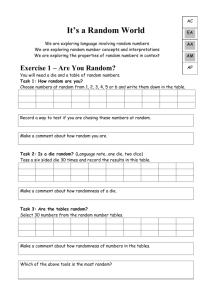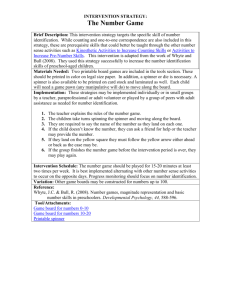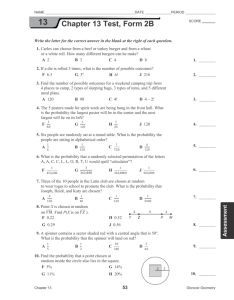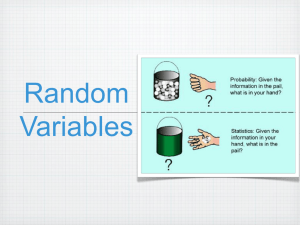RandomNumbersSheet
advertisement
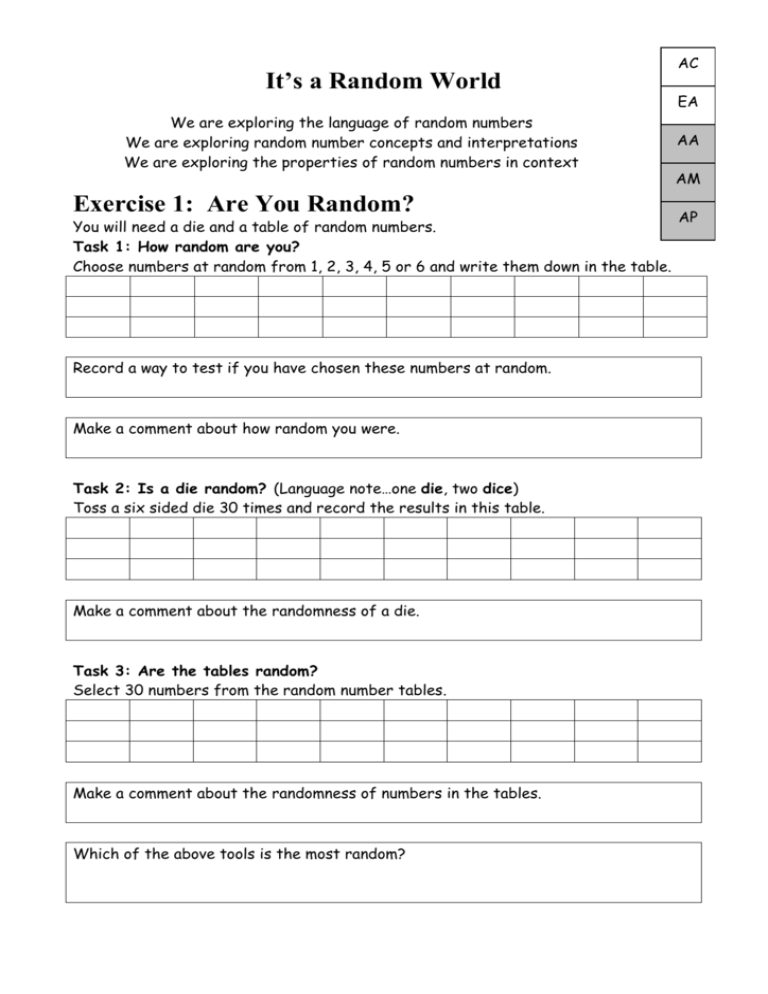
It’s a Random World We are exploring the language of random numbers We are exploring random number concepts and interpretations We are exploring the properties of random numbers in context Exercise 1: Are You Random? You will need a die and a table of random numbers. Task 1: How random are you? Choose numbers at random from 1, 2, 3, 4, 5 or 6 and write them down in the table. Record a way to test if you have chosen these numbers at random. Make a comment about how random you were. Task 2: Is a die random? (Language note…one die, two dice) Toss a six sided die 30 times and record the results in this table. Make a comment about the randomness of a die. Task 3: Are the tables random? Select 30 numbers from the random number tables. Make a comment about the randomness of numbers in the tables. Which of the above tools is the most random? AC EA AA AM AP Exercise 2: Using Random Number Tables Here is a table of random numbers. 4372642424 9406184123 2755600119 6323543161 5667900078 4266091944 9814791469 9637668451 2820777553 8795344562 7314143723 8999350023 9440063906 6394964935 8167958100 5738475399 4613718979 1316222759 6459025117 2563648280 1495965364 1709466538 7004248173 5411818548 2997038372 5462166377 2994696288 6715187556 7811269474 8418537549 1444304159 6258098622 2120873170 2088035029 6994888469 6340649938 3447166378 8632754677 4897600594 5930150461 7474143653 1833110026 6032983174 5262363298 9247172802 3025872706 3916293208 3112528772 4716030335 3790090475 1) How many numbers are there in the table? How do you work that out? 2) Every time you use this table you should get a different set of numbers. Think up a way in which you might be able to do this and write down your method. 3) Use your method and select ten random numbers. Do this 10 times and see if your selection changes every time. Make a comment about your method. My comment. 4) Randy has a method which he describes as follows. (a) Throw a ten sided die to get a number (X) from 1 to 5 (e.g. 3). Throw it again if the number is from 6 to 10 (b) Throw the die again to get another number (Y) from 1 to 10 (e.g. 7) (c) Move to the block X across and Y down. (e.g. 3 across and 7 down) (d) Start using numbers in that block and keep moving to the right and down. Then go to the top and keep going. Use Randy’s method to select 10 random numbers and record them. 5. Write down your method as a series of steps like Randy did. The ___________ Method Exercise 3: Random? How do you know? Knowing that a set of numbers are random can be very important. Some methods to generate random numbers are very good, some not so good and some are very poor. There are also some very strange and some very obvious methods. A simple test of randomness is to expect that every number has an equal chance of being selected. If this happens, once we have selected a reasonably large group of numbers, sorted them and graphed the totals the columns would all be the same height. There should be equal numbers of each number. Let’s see if this works. 1) Count up all the 0, 1, 2 ….9 in the following random number table. 4372642424 9406184123 2755600119 6323543161 5667900078 4266091944 9814791469 9637668451 2820777553 8795344562 Record your totals here. # of 0s = 1s = 5s = 6s = 7314143723 8999350023 9440063906 6394964935 8167958100 5738475399 4613718979 1316222759 6459025117 2563648280 1495965364 1709466538 7004248173 5411818548 2997038372 5462166377 2994696288 6715187556 7811269474 8418537549 2s = 7s = 1444304159 6258098622 2120873170 2088035029 6994888469 6340649938 3447166378 8632754677 4897600594 5930150461 3s = 8s = 2) 7474143653 1833110026 6032983174 5262363298 9247172802 3025872706 3916293208 3112528772 4716030335 3790090475 4s = 9s = Are the numbers of each the same? How many of each would you expect to have? Comment 3) Use the space below to make a bar chart of your results. Does the chart confirm that these numbers are indeed random? Comment Exercise 4: Some Random Events! You will need a creative thinking cap and a buddy. You are to list some ways to generate or make random numbers. Then you are going to choose a method to make the numbers and test to see if they are random. 1. Discuss and list at least 10 ways of making, finding or generating random numbers. Our ways are: 2. Choose one of these ways. Our chosen experiment is: 3. Generate enough numbers to test if your experiment is random. Our numbers are: 4. Record how you are going to test them. Our test is: 5. Now do it. 6. Make a comment about the randomness of your method. Exercise 5: Random or Not? Here is a long list of experiments that could generate or be used to generate random results. You task is to make a comment about the randomness of each experiment. Some of the tasks might not be very random at all. Event 1) Tossing a six sided dice 2) The last digit on number plates of cars. 3) Tossing a coin 4) Using RAND function on a calculator or computer. 5) Throwing a dart at a dart board 6) Kicking a ball at some numbered drums 7) Order of race horses finishing 8) Looking at the second hand on a clock 9) Heights of students 10) Thinking of a number between 1 to 10 11) Looking at the digits in the number π 12) Drawing cards from a pack 13) Tossing a drawing pin 14) Dropping the toast on the floor 15) Where rain drops fall 16) Flicking to a page in a book 17) Looking at the date today 18) Pocketing a ball of a pool break 19) Looking at the digits of one seventh 20) Amount of money of a power bill 21) Estimating the length of a line 22) Number of children in families of your class. 23) Number of children in a class from day to day 24) The number of cricket balls you can hold. 25) Length of time you can hold your breath 26) Number of marks you get in a test 27) Rolling marbles down a slope 28) How many coins in your pocket 29) The number of clouds in the sky Comments Exercise 6: How Many Do I Need? You will need a ten sided die and a friend. Your task is to make a conjecture about how many times you need to toss a dice to know that this is a random way of generating numbers. 1) Since there are ten numbers (0, 1, 2, … 8, 9) we will toss the dice ten times and graph the results. (a) How many of each number do you expect? Comment (b) Results 2) Toss the die ten times. How many of each number did you get? Graph your results. Were ten tosses enough to show the numbers are random? Comment 3) How many times do you think you will need to throw the dice to convince someone that tossing a die has a random outcome? My guess is 4) Investigate your idea and summarise what you find out in the box below. Make a conjecture about how many is enough! Investigation space. My conjecture. Exercise 7: Making a Random Spinner You will need some card, a round tin about 8cm across, scissors, colouring pencils and a tooth pick. TASK A – Making the Spinner You are going to make a spinner that will select the numbers 1, 2, 3 or 4 randomly where all of the numbers are equally likely to be selected. You might need to discuss with your teacher what this means. Steps 1) Draw a circle on your card. 2) Divide the circle into four equal sectors (The lines must cross at the exact middle of the circle) 3) Number and colour the sectors 4) Put the tooth pick through the exact centre. 5) Spin to generate random numbers. 1 4 2 3 The number touching the desk is the chosen number. Have a few practise spins. TASK B – Using the Spinner Now use the spinner to generate enough numbers to test and see if you have made a random 1, 2, 3, 4 number generator. Comment on your spinner. TASK C – Designing a Spinner • EASY Twirl needs to have a spinner that generates the numbers 1 and 2 but the 2 must come up twice as often as the 1. Your task is to make the spinner to do this and test it to see if you are correct. TASK D – Designing a Spinner • HARD Twirl needs to have a spinner that generates the numbers 1, 2 and 3 but the 2 must come up twice as often as the 1 and the 3 has to come up three times as often as the 2. Your task is to make this spinner and test it to see if you are correct. Exercise 8: Going on a Random Walk You will need a die. This is a fun game. Steps to follow. 1. Put your pencil on the dot at the centre of the grid. 2. Toss the die and move - forward one and turn right if you throw an even number - forward one and turn left if you throw an odd number. 3. Repeat moving and turning for 30 tosses of the die drawing your path. Make a comment about the path you travelled. Change to a different colour pencil and try again. Make another comment about the new path. Random Robot Game Mark 10 red dots on the grid and have a friend mark 10 blue dots. Now do a random walk for 30 tosses. Score a point for every one of your colour visited by the robot. Winner has the most points. Invent a new game. Rules…. Exercise 9: Random Walk with No Returns! You will need a die. This is a fun game and has applications in chemistry and molecule design. In this game you are never allowed to return to a place you have visited. In chemistry, two atoms cannot be in the same place so this game is used to explore molecule manufacturing. Steps to follow. 1. Put your pencil on the dot at the centre of the grid. 2. Toss the die and move - forward one and turn right if you throw an even number - forward one and turn left if you throw an odd number. - but if you end up in a place you have been before …throw again. 3. Repeat moving and turning for 30 tosses of the die drawing your path. Make a comment about the path you travelled. Are there any holes or other curious new features? Random Robot Game with No Returns Mark 10 red dots on the grid and have a friend mark 10 blue dots. Now do a random walk for 30 tosses. Score a point for every one of your colour visited by the robot. Winner has the most points. Invent a new game. Rules…. Exercise 10: Random Numbers in Calculators You will need a calculator that can generate random numbers. On a CASIO calculator the function RAND(0) generates a number between 0 and 1 and displays this number as a decimal. Here is an example DISPLAY = 0.367198234 To simulate tossing a coin which has two outcomes, heads and tails we use the function 2xRAND(0) or more simply RAND(2). Try this and keep pressing the ENTER button and see what happens. Record your screen displays here. What function would simulate tossing a dice with 6 sides? My answer is Does it work? Exercise 11: Random Numbers in Computers You will need access to a computer spreadsheet such as EXCEL. On an EXCEL spreadsheet the function RAND() generates a random number between 0 and 1 and displays it as a decimal. Select a cell and type =RAND() and see what happens Here is an example DISPLAY = 0.367198234 To simulate tossing a coin which has two outcomes, heads and tails we use the function 2*RAND(). Copy this calculation to an area of the spreadsheet and see if you can generate the outcomes for tossing a coin 50 times. How could you simulate tossing a dice with 10 sides? My answer is Does it work? Random Numbers Answers Exercise 1: Are You Random? Task 1. Various answers. Most people have numbers they prefer, and these are usually 3, 4, 7, 8. (These numbers include the traditional ‘lucky’ numbers, and are not near the middle or ends which are often avoided subconsciously.) Some number may also have been accidentally omitted, so there is a good chance that you were not random when you chose the numbers you wrote down! Task 2. The data will vary. As there are six possible outcomes, it is unlikely that all have similar frequencies, as 30 is a small number of trials for this sort of experiment. Overall, a die is random in about 90% of cases. Task 3. A similar result as task 2 but 30 is not be enough selections as there are 10 possible outcomes this time. Exercise 2: Using Random Number Tables The answers to this exercise should be discussed with the rest of the group and your teacher 1) 500, 10 groups of 10 numbers in 5 rows. 2) Various methods. Correct if a random way of starting is established, and some system used to find the next number 3) Various. Comment should support randomness. 4) Various 5) Various methods. Correct if a random way of starting is established and some system is used to find the next number Exercise 3: Random? How do you Know? The answers to this exercise should be discussed with the rest of the group and your teacher 1) Totals can vary a little! The totals will not be necessarily be exactly the same as the process is random. 2) 50 of each number is expected. 3) Graph. Discuss this answer with your teacher. Exercise 4 The answers to this exercise should be discussed with the rest of the group and your teacher Exercise 5 The answers to this exercise should be discussed with the rest of the group and your teacher All are random events to some degree. Some will generate numbers, and others, like the coin, other results (though the head can be called a zero and a tail a one, so a coin can generate two random numbers…). Some of the experiments do not generate true random results. For example, when throwing a dart at a board a person is usually aiming for something, so the dart is more likely to land closer to the aimed point than further away – especially if that person has practised a lot! Exercise 6 The answers to this exercise should be discussed with the rest of the group and your teacher 1) (a) 1 or 2. (b) various 2) No. Variation too great in small groups. 3) Various. About 50 tosses would be OK. 4) Conjectures will vary Exercise 7 The answers to this exercise should be discussed with the rest of the group and your teacher Task A. Successful manufacture needs a medal. Task B. Various answers Task C. The ‘two’ sector will be twice the angle of the 1 sector; 240:to 120. Task D. 9 parts. Each part 40degrees. 1 is 40, 2 is 80 and 3 is 240 degrees. These areas do not have to be contiguous. Exercise 8 All responses various and random. Exercise 9 All responses various and random. Exercise 10 All responses various and random. Exercise 11 All responses various and random.
